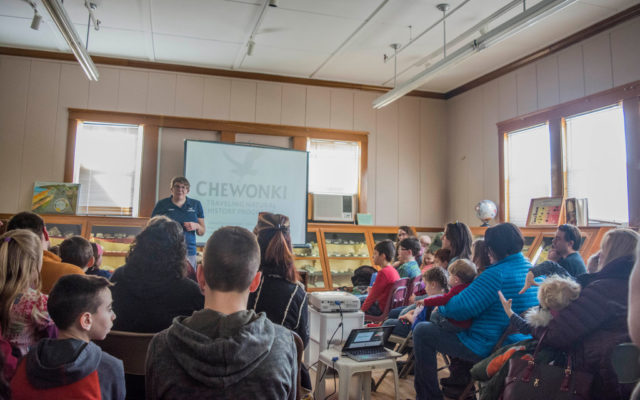
CARIBOU, Maine — The Nylander was overflowing with over 100 guests for the Feb. 22 Chewonki event, which focused on the importance of wild predators.
Chewonki Wildlife Educator Jessica Woodend embarked on a nearly five hour drive from Wiscasset to Caribou, bringing an owl, tarantula, and lizard along for the ride. As she began setting up for the presentation, guests filled every chair in the room and resorted to standing. In a matter of minutes, a large group of late attendants stood outside the door in the lobby to watch her discuss the vital role natural predators play in the world.
Woodend began by showing the kids a drawing of an anthropomorphized fox dressed like a robber, and explained that these animals are often portrayed as “the bad guys in stories, cartoons, and movies,” and asked the young audience if they believed all foxes were bad animals.

Jessica Woodend, a wildlife educator with the Chewonki Foundation, holds “Caribou” the owl during a Feb. 22 event at the Nylander Museum in Caribou which focused on wild predators.
(Chris Bouchard)
After a resounding “no” from the kids, she explained all living things play a part in co-existing with one another.
“They’re usually the bad guys in our stories,” she said, “but we can sometimes be the bad guys in their stories. So we have to try to coexist, so they can have their spaces and we can have ours.”
To elaborate on this point, Woodend explained that all animals, whether they’re predator or prey, are doing what they need to do in order to survive. Zebras, she said, eat plants, and lions eat zebras. But if there were no lions to eat the zebras, they would overpopulate and eat all of the plants, and eventually starve.
She asked the audience if they knew the word for animals that only eat plants.
“Herbivores,” a young attendant shouted out.
When asked to provide examples of herbivores, children yelled out several examples: “Cows,” “Deer,” “Moose.”
Woodend’s keen audience also gave examples of omnivores, such as bears, as she built a pyramid with cups to illustrate the natural balance maintained by plants, herbivores, omnivores, and carnivores.
As she passed around two eagle feathers, one being from a bald eagle which, she explained, required “lots of special permits” to obtain, Woodend showed children and their families a photo of a cat catching a mouse to help illustrate the stigma that wild predators have compared to their domesticated relatives.
“Why do we feel differently when watching this animal eat than when watching lions,” she asked.
“Mice are pests,” said one child in the audience.
“Exactly,” said Woodend. “So cats might be doing us a favor. Do the cats we have in our house need to eat these mice to survive?”
“No,” said a few children in unison.

Well over 100 visitors came to see the Chewonki Foundation program on predators at the Nylander Museum on Feb. 22. (Chris Bouchard)
Woodend agreed, adding that most of the time cats aren’t even eating mice, they’re just following their natural hunting instincts.
Chewonki obtains their live animals after a rehab or animal care center deems them to be non-releasable. Woodend said the saw-whet owl she brought, for example, was rescued in the area, prompting Chewonki to name her “Caribou” once they obtained her.
“Back in the day when saws were sharpened without machinery,” she said, “we would use a whetstone to sharpen saws. They got their name because their call sounds like a saw being sharpened on a whetstone.”
In addition to the owl, dragon lizard, and tarantula, Woodend also brought a stuffed fisher cat in glass, the skull of a black bear that was hit by a car, and the fur of a coyote.
After the event Nylander board member Gail Hagelstein said well over 100 people were in attendance on Friday and that she’d never witnessed so many simultaneously attend an event at the museum before.
Deborah Nichols, also of the Nylander board, was responsible for coordinating Chewonki’s visit.
“They came last year,” said Nichols, “so I called and asked them about their programs. They have 15 different presentations and we decided as a board to go with the predators presentation, which ties in with our Dino Days event.”
More than 100 children participated in Dino Days during school vacation, Feb. 16-24. The most popular aspect of the event was the “fossil dig” in which youngsters could chip away at plaster encasing a plastic dinosaur. So many children attended that members of the board had to quickly buy more plant pots for the plaster in order to fit the demand.
“We had quite a few donations this week,” Nichols said. “I worked on Tuesday and I had about 30 kids in here breaking through the plant pots and looking for dinosaurs. There was dust everywhere. We can’t keep those plant pots during Dino Days.”
- Well over 100 visitors came to see the Chewonki Foundation program on predators at the Nylander Museum on Feb. 22. (Chris Bouchard)








